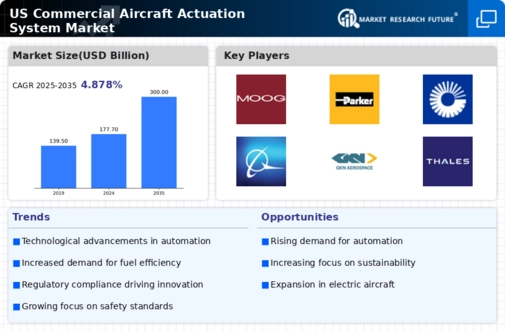Expansion of the Aviation Sector
The expansion of the aviation sector in the United States is a significant driver for the commercial aircraft-actuation-system market. With increasing passenger traffic and the growth of low-cost carriers, the demand for new aircraft is on the rise. This expansion necessitates the development and integration of advanced actuation systems to ensure optimal performance and safety. According to forecasts, the U.S. aviation market is expected to grow by approximately 4% annually over the next decade, leading to increased orders for aircraft equipped with state-of-the-art actuation systems. This growth trajectory suggests a robust demand for innovative solutions within the commercial aircraft-actuation-system market, as manufacturers strive to meet the needs of a burgeoning industry.
Rising Demand for Fuel Efficiency
the commercial aircraft-actuation-system market is influenced by the rising demand for fuel efficiency among airlines. As fuel costs continue to represent a substantial portion of operational expenses, airlines are increasingly investing in technologies that enhance fuel economy. Actuation systems that contribute to weight reduction and improved aerodynamics are particularly sought after. Industry reports suggest that the implementation of advanced actuation systems can lead to fuel savings of up to 15%, making them an attractive option for cost-conscious airlines. This growing emphasis on fuel efficiency is likely to propel the commercial aircraft-actuation-system market, as manufacturers respond to the needs of the aviation sector.
Regulatory Compliance and Standards
Regulatory compliance plays a pivotal role in shaping the commercial aircraft-actuation-system market. The Federal Aviation Administration (FAA) and other regulatory bodies impose stringent standards for safety and performance, compelling manufacturers to innovate continuously. Compliance with these regulations not only ensures safety but also enhances market competitiveness. As airlines and manufacturers strive to meet these evolving standards, investments in advanced actuation technologies are likely to increase. This focus on compliance is expected to drive market growth, as companies that can demonstrate adherence to regulations may gain a competitive edge. The financial implications of non-compliance can be substantial, further motivating stakeholders to prioritize regulatory alignment in their operations.
Increased Focus on Environmental Sustainability
Environmental sustainability is becoming a critical driver in the commercial aircraft-actuation-system market. With growing concerns over climate change and emissions, the aviation industry is under pressure to adopt greener technologies. Actuation systems that utilize electric or hybrid technologies are gaining traction as they promise lower emissions and reduced environmental impact. The push for sustainable aviation practices is likely to lead to increased investments in research and development of eco-friendly actuation solutions. As airlines aim to meet sustainability targets, the demand for innovative actuation systems that align with these goals is expected to rise, thereby influencing the commercial aircraft-actuation-system market positively.
Technological Advancements in Actuation Systems
The commercial aircraft-actuation-system market is experiencing a surge in technological advancements, particularly in the development of more efficient and lightweight actuation systems. Innovations such as smart actuators and advanced materials are enhancing performance and reducing weight, which is crucial for fuel efficiency. The integration of these technologies is expected to drive market growth, as airlines seek to optimize operational costs. According to industry estimates, the market for advanced actuation systems is projected to grow at a CAGR of approximately 5.5% over the next five years. This trend indicates a strong demand for cutting-edge solutions that improve aircraft performance and reliability, thereby influencing the commercial aircraft-actuation-system market significantly.

























Leave a Comment